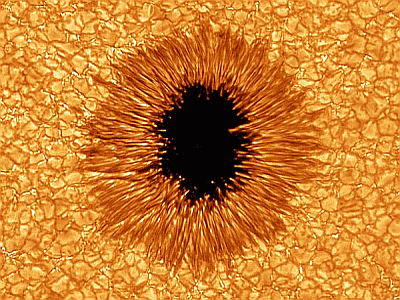First, to recap, we know that there is a roughly 11 year sunspot cycle where we go from essentially no sunspots on the surface of the Sun to a period of high sunspot activity and then back to essentially no sunspots again.
Keep in mind that the sunspots themselves don't move (although they appear to from Earth during the rotation of the Sun) but form, typically exist for a couple of weeks or more, and then dissipate. Where they pop up on the surface of the Sun, however, is what changes during the sunspot cycle and is reflected on the butterfly diagram above.
What else have we learned about sunspots?
Well, a sunspot can be over 50,000 km across (for reference, the diameter of the Earth is about 12,750 km) and consists of two visible parts - the darker central umbra (Latin for shadow) and the lighter surrounding penumbra (the Latin prefix means almost or nearly). The image below shows a large sunspot group (AR 1339 from November 4) with a filtered telescope. Note the clearly visible umbra and penumbra for each sunspot.
Sunspots are darker than the surrounding Sun because they're cooler. The surface of the Sun is around 6000 K (over 10,000° F) and sunspots are 1500 K (~2250°) or more cooler. So, while they appear dark compared to the rest of the Sun, if you could somehow take a sunspot off the Sun and place it by itself in space, it would glow brightly in the sky!
The next image shows a sunspot a bit more dramatically. This image was taken in August of 2010 at the Big Bear Solar Observatory in the San Bernadino Mountains of California. This image was taken with a special filter called a hydrogen alpha (Ha) filter. It's a filter that only passes a narrow bandwidth of visible light at a wavelength of 656 nm (6.56 x 10-7 m). This is the energy given off by electrons in a hydrogen atom falling from the 3rd to the 2nd orbital. The Sun, being a big ball of mostly hydrogen gas, gives off a lot of energy at this wavelength and these filters bring out a lot of detail on the "surface" (photosphere) of the Sun.
This image shows a granulation around the sunspot. Those are the tops of convection cells where hot gases are "bubbling" up from deeper in the Sun. Here's a neat animation of solar activity.
This convection of hot, ionized gas (plasma) generates the Sun's magnetic field. Because the Sun is a big ball of gas, it doesn't rotate at the same speed everywhere - it takes about a 9 days less to rotate at the equator (~25 days) than it does near the poles (~34 days). This differential rotation leads to magnetic flux tubes in the convection zone of the Sun getting twisted up (they actually behave much like rubber bands). This inhibits convection and leads to the development of a cooler sunspot (don't ask me to explain this any better since I'm not a solar physicist).
Magnetic lines of force also pop up above the photosphere often leading to the formation of two sunspots of opposite magnetic polarity (one where the magnetic field emerges from the photosphere, the other where it reenters the Sun). Sunspots have about 1000 times more magnetic energy than surrounding areas of the Sun.
Below is a magnetogram image of the Sun for today (November 13). Black indicates areas where the Sun's magnetic lines of force are coming toward us and white indicates areas where the Sun's magnetic lines of force are moving away from us. Compare this to the visible image of the Sun for today and you can see that major black and white areas correlate with the positions of sunspots.
Another interesting thing about the magnetic field of the Sun is that it has a 22-year cycle. Every 11 years it reverses its polarity (i.e. the north and south magnetic poles flip). Obviously closely tied into the 11-year sunspot cycle!
So, you may be thinking, sunspots are cool looking features on the surface of the Sun that we don't fully understand but do they have any significance for us here on Earth? Yes, as a matter of fact they do. That will be the topic of the next post.












"Another interesting thing about the magnetic field of the Sun is that it has a 22-year cycle. Every 11 years it reverses its polarity (i.e. the north and south magnetic poles flip). Obviously closely tied into the 11-year sunspot cycle!"
ReplyDeleteThat's ridiculous - I had no idea! Makes me wonder what similarities solar polarity reversals have to those on Earth...